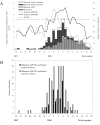Influenza A(H1N1) Oseltamivir Resistant Viruses in the Netherlands During the Winter 2007/2008
- PMID: 22253652
- PMCID: PMC3249654
- DOI: 10.2174/1874357901105010154
Influenza A(H1N1) Oseltamivir Resistant Viruses in the Netherlands During the Winter 2007/2008
Abstract
Background: Antiviral susceptibility surveillance in the Netherlands was intensified after the first reports about the emergence of influenza A(H1N1) oseltamivir resistant viruses in Norway in January, 2008.
Methods: Within the existing influenza surveillance an additional questionnaire study was performed to retrospectively assess possible risk factors and establish clinical outcome of all patients with influenza virus A(H1N1) positive specimens. To discriminate resistant and sensitive viruses, fifty percent inhibitory concentrations for the neuramidase inhibitors oseltamivir and zanamivir were determined in a neuraminidase inhibition assay. Mutations previously associated with resistance to neuramidase inhibitors and M2 blockers (amantadine and rimantadine) were searched for by nucleotide sequencing of neuraminidase and M2 genes respectively.
Results: Among 171 patients infected with A(H1N1) viruses an overall prevalence of oseltamivir resistance of 27% (95% CI: 20-34%) was found. None of influenza A(H1N1) oseltamivir resistant viruses tested was resistant against amantadine or zanamivir. Patient characteristics, underlying conditions, influenza vaccination, symptoms, complications, and exposure to oseltamivir and other antivirals did not differ significantly between patients infected with resistant and sensitive A(H1N1) viruses.
Conclusion: In 2007/2008 a large proportion of influenza A(H1N1) viruses resistant to oseltamivir was detected. There were no clinical differences between patients infected with resistant and sensitive A(H1N1) viruses. Continuous monitoring of the antiviral drug sensitivity profile of influenza viruses is justified, preferably using the existing sentinel surveillance, however, complemented with data from the more severe end of the clinical spectrum. In order to act timely on emergencies of public health importance we suggest setting up a surveillance system that can guarantee rapid access to the latter.
Keywords: Drug resistance; Epidemiology; H1N1 subtype; Influenza A virus; Netherlands; Oseltamivir; Signs and symptoms; Surveillance; Viral; Virology..
Figures



Similar articles
-
Emergence of H274Y oseltamivir-resistant A(H1N1) influenza viruses in Japan during the 2008-2009 season.J Clin Virol. 2010 Jan;47(1):23-8. doi: 10.1016/j.jcv.2009.11.003. Epub 2009 Dec 3. J Clin Virol. 2010. PMID: 19962344
-
The Emergence of Oseltamivir-Resistant Seasonal Influenza A (H1N1) Virus in Korea During the 2008-2009 Season.Osong Public Health Res Perspect. 2011 Dec;2(3):178-85. doi: 10.1016/j.phrp.2011.11.042. Osong Public Health Res Perspect. 2011. PMID: 24159470 Free PMC article.
-
Triple combination of amantadine, ribavirin, and oseltamivir is highly active and synergistic against drug resistant influenza virus strains in vitro.PLoS One. 2010 Feb 22;5(2):e9332. doi: 10.1371/journal.pone.0009332. PLoS One. 2010. PMID: 20179772 Free PMC article.
-
Influenza viruses - antiviral therapy and resistance.GMS Infect Dis. 2017 Apr 25;5:Doc04. doi: 10.3205/id000030. eCollection 2017. GMS Infect Dis. 2017. PMID: 30671326 Free PMC article. Review.
-
Influenza neuraminidase inhibitors: antiviral action and mechanisms of resistance.Influenza Other Respir Viruses. 2013 Jan;7 Suppl 1(Suppl 1):25-36. doi: 10.1111/irv.12047. Influenza Other Respir Viruses. 2013. PMID: 23279894 Free PMC article. Review.
Cited by
-
Virological characterization of influenza H1N1pdm09 in Vietnam, 2010-2013.Influenza Other Respir Viruses. 2015 Jul;9(4):216-24. doi: 10.1111/irv.12323. Influenza Other Respir Viruses. 2015. PMID: 25966032 Free PMC article.
-
The 2009 influenza A (H1N1) pandemic. Management and vaccination strategies in The Netherlands.Bundesgesundheitsblatt Gesundheitsforschung Gesundheitsschutz. 2013 Jan;56(1):67-75. doi: 10.1007/s00103-012-1582-4. Bundesgesundheitsblatt Gesundheitsforschung Gesundheitsschutz. 2013. PMID: 23275958 Free PMC article.
References
-
- Simonsen L. The global impact of influenza on morbidity and mortality. Vaccine. 1999;17(Suppl 1):S3–10. - PubMed
-
- Kramarz P, Monnet D, Nicoll A, Yilmaz C, Ciancio B. Use of oseltamivir in 12 European countries between 2002 and 2007--lack of association with the appearance of oseltamivir-resistant influenza A(H1N1) viruses. Eur Surveill. 2009;14(ii):19112. - PubMed
-
- Meijer A, Lackenby A, Hay A, Zambon M. Influenza antiviral susceptibility monitoring activities in relation to national antiviral stockpiles in Europe during the winter 2006/2007 season. Eur Surveill. 2007;12:E3–4. - PubMed
-
- Jonges M, Van Der Lubben IM, Dijkstra F, Verhoef L, Koopmans M, Meijer A. Dynamics of antiviral-resistant influenza viruses in the Netherlands, 2005-2008. Antiviral Res. 2009;83:290–7. - PubMed
-
- Escuret V, Frobert E, Bouscambert-Duchamp M, et al. Detection of human influenza A (H1N1) and B strains with reduced sensitivity to neuraminidase inhibitors. J Clin Virol. 2008;41:25–8. - PubMed
LinkOut - more resources
Full Text Sources
